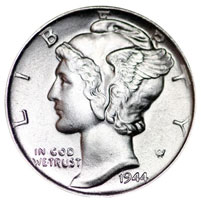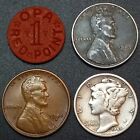Mercury Dimes For Sale
The Mercury Dime, a captivating and iconic piece of American coinage, represents a pinnacle in artistic expression within the numismatic world. Minted from 1916 to 1945, this dime features a timeless design by Adolph A. Weinman, showcasing Liberty donned in a winged cap. In this exploration, we delve into the history, design brilliance, and the most valuable dates and versions of the Mercury Dime.

1916: The Birth of a Classic Design
The Mercury Dime, introduced in 1916, marked a departure from the more traditional designs of earlier coins. Adolph A. Weinman’s vision brought forth a coin that combined elegance, symbolism, and a touch of classical grace. Despite its colloquial name, the figure on the obverse is not the Roman god Mercury but a depiction of Liberty with a winged cap, a symbol of freedom of thought.
Key Date: 1916-D Mercury Dime
The inaugural year, 1916, holds a key date within the Mercury Dime series. The 1916-D Mercury Dime, minted in Denver, has achieved legendary status among collectors. With a mintage of just over 264,000, its scarcity makes it a highly sought-after piece in the world of numismatics. Collectors often find the pursuit of the 1916-D to be a challenging yet rewarding endeavor.
1921: A Year of Rarity
The year 1921 witnessed a scarcity of dimes due to increased demand for coinage. The Mercury Dime, being no exception, saw lower mintages. The 1921 Mercury Dime is particularly sought after by collectors due to its rarity. Its place in history as part of a challenging year for coin production adds to its allure.
Artistry in Motion: The Design Details
Adolph A. Weinman’s design for the Mercury Dime is a masterpiece of numismatic artistry. Liberty’s profile is framed by a winged cap, symbolizing freedom of thought, while the reverse features a fasces, an ancient symbol of authority. The intricate details, such as the feathers on the cap and the olive branch in the eagle’s talons, showcase the meticulous craftsmanship that went into creating these small yet exquisite coins.
1931-S: The Scarce Survivor
As the Great Depression took its toll, mintages for many coins decreased, making certain years scarcer than others. The 1931-S Mercury Dime, struck in San Francisco, is one such example. With a mintage of around 1.8 million, it stands out as a relatively scarce date in the series. Collectors keen on completing their Mercury Dime collections often find the 1931-S to be a challenging acquisition.
Collecting Mercury Dimes: The Pursuit of Complete Sets
For collectors, assembling a complete set of Mercury Dimes involves navigating the various mintages, mintmarks, and potential variations within the series. The pursuit is not just about acquiring coins; it’s about capturing the essence of a specific era in American history through these small, silver canvases.
1938-D: The Last of a Storied Series
The Mercury Dime series concluded in 1945, marking the end of an era. The 1938-D Mercury Dime, minted in Denver, holds significance as the final year of production. While not as rare as some earlier dates, it represents the culmination of a storied series that left an indelible mark on American coinage.
Full Bands: A Grading Distinction
Collectors often pay close attention to the details when evaluating the condition of Mercury Dimes. The term “Full Bands” (FB) refers to the distinct separation between the horizontal bands on the fasces on the reverse of the coin. Mercury Dimes with Full Bands command a premium in the market, as they are considered to have superior strike and detail.
Market Dynamics: Rarity and Demand
The market for Mercury Dimes is influenced by factors such as rarity, condition, and collector demand. High-grade examples and coins with desirable attributes, such as Full Bands, often fetch premium prices at auctions and from specialized coin dealers. The allure of owning a well-preserved, historically significant Mercury Dime continues to drive demand among numismatists.
Conclusion: The Enduring Allure of the Mercury Dime
The Mercury Dime, with its timeless design and historical significance, remains a cornerstone in the world of coin collecting. From the challenge of acquiring key dates like the 1916-D to appreciating the artistry in each finely detailed coin, collectors find the Mercury Dime series to be a rewarding pursuit. As these small silver gems continue to stand the test of time, they carry with them not only the history of a nation but also the artistry of a bygone era in American numismatics.
1916 D Mercury Dime -The First Year Circulated Dollar
 | $33.96 Buy It on eBay for only: $33.96 Buy It Now on eBay |
✯ Estate Mercury Silver Dime UNC++ MS BU ✯ Old 90% Silver RARE ✯
 | $19.85 Buy It on eBay for only: $19.85 Buy It Now on eBay |
US COINS- Silver Mercury Dime, Wheat & Steel Cent Set, OPA Token- WW2 COIN LOT
 | $8.95 Buy It on eBay for only: $8.95 Buy It Now on eBay |
ONE Mercury Silver Dime 1916 - 1945
 | $4.23 Buy It on eBay for only: $4.23 Buy It Now on eBay |
1939 Mercury Dime PCGS Genuine UNC Details (Wheel Mark) 90% Silver
 | $44.99 Buy It on eBay for only: $44.99 Buy It Now on eBay |
35 (3.50 Face) Silver Mercury Dime Lot 1927-45.
 | $130.00 Buy It on eBay for only: $130.00 Buy It Now on eBay |
VG+ 1923-S Mercury 90% Silver Dime
 | $7.95 Buy It on eBay for only: $7.95 Buy It Now on eBay |
Estate Mercury Silver Dime ~ UNC++ MS BU ~ Old 90% Silver Lot RARE ~ ONE COIN
 | $19.80 Buy It on eBay for only: $19.80 Buy It Now on eBay |
VG+ 1925-S Mercury 90% Silver Dime
 | $7.95 Buy It on eBay for only: $7.95 Buy It Now on eBay |
90% Silver Mercury Dime 50-Coin Roll Avg Circ (2 Rolls)
 | $421.42 Buy It on eBay for only: $421.42 Buy It Now on eBay |
VG+ 1927-S Mercury 90% Silver Dime
 | $7.95 Buy It on eBay for only: $7.95 Buy It Now on eBay |
1926-P Mercury 90% Silver Dime
 | $6.95 Buy It on eBay for only: $6.95 Buy It Now on eBay |
1943 Mercury Silver Dime - BU
 | $1.99 End Date: Wednesday Nov-19-2025 06:50:31 EST Buy It on eBay for only: $1.99 Buy It Now on eBay |
(10) Mercury Dime AU-BU About Uncirculated-Uncirculated 90% Silver
 | $114.89 Buy It on eBay for only: $114.89 Buy It Now on eBay |
MIRROR FINISH Mercury Dime - 90% Silver Vintage Circulated US Coin - Full Date
 | $12.99 Buy It on eBay for only: $12.99 Buy It Now on eBay |
✯ Estate Mercury Silver Dime UNC++ MS BU ✯ Old 90% Lot Silver RARE ✯
 | $19.45 Buy It on eBay for only: $19.45 Buy It Now on eBay |
1941 Mercury Head Dime CAC MS64
 | $30.00 Buy It on eBay for only: $30.00 Buy It Now on eBay |
MERCURY DIMES - 10 Cents - 90% SILVER COINS
 | $3.75 Buy It on eBay for only: $3.75 Buy It Now on eBay |
1926 S Mercury Dime CHEAP !!!
 | $11.95 Buy It on eBay for only: $11.95 Buy It Now on eBay |
VG+ 1920-S Mercury 90% Silver Dime
 | $7.95 Buy It on eBay for only: $7.95 Buy It Now on eBay |